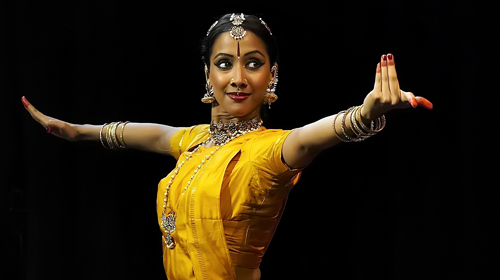Alum gives traditional dance a modern twist

Mythili Prakash will perform at the Harold M. Williams Auditorium at the Getty Center this weekend as part of “The Sounds of L.A.” concert series.
By Jeremy Lu
Feb. 10, 2010 9:07 p.m.
Both in her performance and in her life, Mythili Prakash is, quite simply, a bridge. A master of Bharata Natyam, a storied South Indian dance ritual, the Los Angeles-born dancer and UCLA alumna is the manifestation of a cultural rendezvous.
Her distinctive position as a 26-year-old perpetuating a 3,000-year-old art form makes her an ideal cross-generational torchbearer, carrying the flame of traditional forms while invigorating the style with her own contemporary twist.
Prakash seamlessly connects music and dance. It is this quality that Prakash will explore in her dance recital this weekend at the Getty Center as part of “The Sounds of L.A.” concert series.
The series typically attempts to highlight diverse musical achievements, and Prakash’s dance numbers are not only a welcome change of pace, but a fitting inclusion.
“Music is an integral part of the art form, and so that fits very much into “˜The Sounds of L.A.’ But in this particular art form, you can’t really separate the music from the dance, and so it’s really two halves of a whole. We’re excited to present this type of music along with the dance component,” programming director Sarah McCarthy said.
Prakash initially became interested in Bharata Natyam dance under the careful instruction of her mother, an experienced dancer.
“I grew up watching her and being in awe of her grit and determination. Her single-minded focus on the art is something that has been drilled into me, and I know no other way to pursue it,” Prakash said.
For Prakash, the deep connection between music and dance has been cultivated from a young age, simply as a product of her traditional Indian upbringing.
“I really had no option but to start dancing. I grew up completely immersed in it,” Prakash said. “I absolutely adored it from the start, and my fascination with it continued endlessly.”
Already a prodigious talent, Prakash looked to hone her skill at UCLA, yet found something entirely different than what she expected.
“I learned a lot from watching my peers and mentors of various dance backgrounds, their approaches to choreography, be it what inspires them to create a piece or their choreographic processes,” Prakash said. “The process of observing and dialoguing broadened my perception of choreography.”
This new perspective reinforced the idea that she was perhaps at a crossroads in regard to her art form.
“Being at UCLA that particular point in my dance life re-emphasized the importance of being immersed in the cultural environment specific to my art form during these pivotal years of my artistic development,” Prakash said.
Prakash’s time at UCLA left her searching for a stimulation the U.S. could no longer provide. Feeling that she had exhausted all of her creative options in the U.S., Prakash moved to India, the home of Bharata Natyam, in search of new muses.
“Bharata Natyam is ultimately a cultural art form. Therefore, India is the natural environment. There, one has constant access to resources ““ literature, poetry, history, sculpture, music, painting, theater, all of which inspire the art form,” Prakash said.
An American citizen, Prakash considers her new home beneficial, even central, to her performance.
“I love America, since I have grown up here, but comparatively it’s a new country. India has so much ancient history and heritage, and I find the environment extremely inspiring,” Prakash said. “I think the move has allowed me to find more depth in the art form. Of course the art form communicates universally, but being in the country of its origin and working there is like working from the nucleus.”
Prakash’s wealth of experience has culminated in a dynamic performance, transcending traditional barriers by including contemporary influences.
“My dance and choreography, naturally, is a reflection of myself and my experiences as a person. My dance language vocabulary is completely classical, but my interpretations are both traditional and contemporary,” Prakash said. “Those words, to me, go completely hand in hand. The art form is dynamic. Yes, it is based on a tradition, and hence traditional, but it is also contemporary. That is the only way it can communicate, engaging both the artist and the audience.”
Series curator Sabrina Motley said Prakash’s open incorporation of new themes and ideas into a traditional art form was a large reason why she was chosen for the series.
“She has this great technique and a deep understanding of this tradition, and also, she’s willing to innovate,” Motley said.
Ultimately, however, Prakash’s effortless integration of music in her dance attracted Motley the most.
“For some dancers, it would be more difficult for them to share the spotlight with their musicians. I think Mythili is not one of them,” Motley said. “She has a clear understanding of how important her musicians are to her work.”


